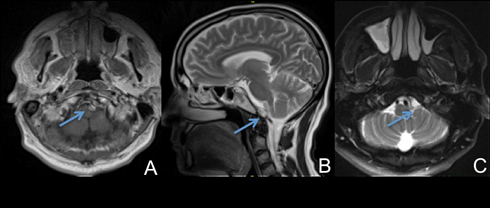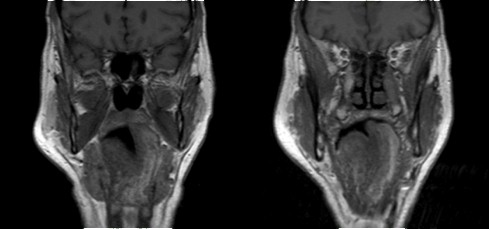- About ACNS
- Meetings
- Education
- Practice
- Research
- Advocacy
- Membership
Contributed by
Julia B. Whitlock, MD; Mayo Clinic Jacksonville, Florida
A 67 year-old man presented with a 7 month history of dysarthria and “swollen tongue” after a prodrome of headaches, myalgias, neck pain, nausea, and vomiting. He was evaluated at onset and treated for Streptococcal pharyngitis but did not improve. At the time of neurologic evaluation, his exam was remarkable for flaccid dysarthria, bilateral (left greater than right) tongue weakness and atrophy but no other bulbar weakness. The rest of the neurologic exam was normal. Lingual needle EMG showed increased insertional activity with fibrillation potentials on the left and high amplitude, long duration motor unit potentials with moderately reduced recruitment bilaterally. MRI of the brain with and without contrast showed a well-defined peripherally enhancing 14 x 7 mm T2 extradural hyperintense focus in the left premedullary cistern at the level of and cephalad to the left hypoglossal canal, consistent with a skull based ganglion or synovial cyst with involvement of the proximal aspect of the left hypoglossal canal and impression on the left hypoglossal nerve.
Does a left-sided hypoglossal neuropathy explain the bilateral denervation seen on lingual needle EMG and MRI?

Figure 1. Ovoid 14 mm T2 hyperintense lesion (arrow, panels B, C) with marginal enhancement (arrow, panel A) arising from the left atlantooccipital joint with extension into the left hypoglossal canal.

Figure 2. Coronal T1 weighted brain MRI demonstrates fatty infiltration (arrow) and denervation change, most prominent in the left hemi-tongue. Less severe denervation changes are seen in the right tongue.
Answer & Discussion:
Bilateral Needle EMG Changes in A Unilateral Hypoglossal Neuropathy - Case Discussion
The human tongue is comprised of 11 total muscles, 5 paired (hyoglossus, styloglossus, genioglossus, inferior longitudinal, transverse/vertical) and 1 unpaired (superior longitudinal). The tongue is considered a muscular hydrostat, an organ with a closely packed 3-dimensional musculature lacking typical skeletal support, able to easily change configuration while maintaining a constant volume. This structure allows for complex and highly controlled movements such as elongation, shortening, bending, and torsion. Tongue control is an essential function for vocalization, feeding, and also plays a role in breathing. Innervation to the tongue has traditionally been described from the ipsilateral hypoglossal nerve; however, these data come from non-human animal studies.
Human anatomic studies and electrodiagnostic studies have been lacking; however, recently Kubin et al. demonstrated electrophysiologic evidence of crossed-motor innervation in the base of the human tongue. Prior data has shown the portion of the genioglossus muscle with longitudinally oriented muscle fibers to have 2 identifiable motor end-plates (MEP) located in the posterior half of the muscle (Mu and Sanders 2010, in Kubin et al. 2015). Therefore, they postulated that potentials could be recorded from a single motor unit using multiple electrodes oriented in an anterior to posterior direction if a strict temporal relationship between recording electrodes could be established, with the potential arriving earlier at the posterior electrode owing to its closer proximity to the MEP. Wire electrodes were inserted into the anterior and posterior genioglossus muscle, offset by approximately 3 mm on either side of midline, into previously determined ultrasonic coordinates. The 4 lingual EMG traces were then inspected for identifiable spike trains possibly generated by a single motor unit (SMU) in at least one of the tracings based on amplitude and interspike interval. Once a reliable SMU triggering action potential was identified, spike-triggered averaging (STA) was used to identify temporally related, non-zero latency potentials of similar configuration and duration at the other 3 recording sites. Contralateral STA potentials were found in approximately half (48%) of trigger-recording combinations, supporting the hypothesis of crossed-motor innervation to the base of the tongue (Kubin et al. 2015).
Our patient was referred to neurosurgery after the discovery of the cervical cyst on MRI. He underwent suboccipital craniectomy for cyst resection. Intraoperatively, a large, soft cystic appearing structure was noted anterior and inferior to the left hypoglossal nerve arising from the atlantooccipital joint. The cyst could not be fully resected due to its adherent nature; however, mucinous material was expressed after cyst puncture with adequate decompression of the hypoglossal nerve. The patient’s dysarthria improved after surgery.
Spinal synovial cysts are rare in the cervical spine. Unilateral hypoglossal neuropathy from a skull based cyst is an even rarer occurrence, with only several cases reported in the literature. Needle EMG is helpful in confirming hypoglossal neuropathy. Crossed motor innervation to the tongue has significant clinical implications in the workup and management of unilateral hypoglossal neuropathy. Bilateral denervation changes can result from a unilateral hypoglossal nerve lesion; therefore, the electromyographer should be aware of crossed innervation to the tongue.
References: